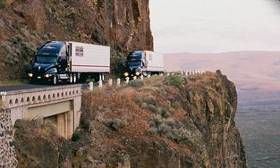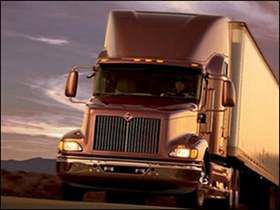CDL Student In Trainer. Wanted To Say Thanks.
Topic 1014 | Page 1

OOoops, should have said "student in training." my mistake.
Congratulations Mark!
Definitely keep us posted, we always enjoy seeing people come through here and get started on a new and exciting career. I know it's a great sense of accomplishment and satisfaction to Brett when he sees so many people benefiting from the training materials he developed. It was no small effort that went into developing the High Road Training Program and therefore it's not surprising to see the great results that people are getting from utilizing it's unique teaching method.
You feel free to ask anything that you're wondering about, no one's going to treat you like you're ignorant around here. There are no dumb questions, and the only questions that go unanswered are the ones that son't get asked.
Keep it up, it won't be long and you're gonna have that CDL in hand and a whole new horizon of opportunity before you.
CDL:
Commercial Driver's License (CDL)
A CDL is required to drive any of the following vehicles:
- Any combination of vehicles with a gross combined weight rating (GCWR) of 26,001 or more pounds, providing the gross vehicle weight rating (GVWR) of the vehicle being towed is in excess of 10,000 pounds.
- Any single vehicle with a GVWR of 26,001 or more pounds, or any such vehicle towing another not in excess of 10,000 pounds.
- Any vehicle, regardless of size, designed to transport 16 or more persons, including the driver.
- Any vehicle required by federal regulations to be placarded while transporting hazardous materials.
Sir, before you go out with a trainer make sure you memorize the entire section 'Weight & Balance'. It will make your life a lot easier knowing how to balance your load and it will surely impress your trainer.
OWI:
Operating While Intoxicated
Welcome aboard Mark! Glad to hear our High Road Training Program was helpful. It's a great system, isn't it?
I checked out your progress and Daniel is right - you're going to want to go through the Weight & Balance section after you complete the Logbook section of course. Those two sections are the most critical for doing your job out there.
CDL:
Commercial Driver's License (CDL)
A CDL is required to drive any of the following vehicles:
- Any combination of vehicles with a gross combined weight rating (GCWR) of 26,001 or more pounds, providing the gross vehicle weight rating (GVWR) of the vehicle being towed is in excess of 10,000 pounds.
- Any single vehicle with a GVWR of 26,001 or more pounds, or any such vehicle towing another not in excess of 10,000 pounds.
- Any vehicle, regardless of size, designed to transport 16 or more persons, including the driver.
- Any vehicle required by federal regulations to be placarded while transporting hazardous materials.
Logbook:
A written or electronic record of a driver's duty status which must be maintained at all times. The driver records the amount of time spent driving, on-duty not driving, in the sleeper berth, or off duty. The enforcement of the Hours Of Service Rules (HOS) are based upon the entries put in a driver's logbook.
HOS:
Hours Of Service
HOS refers to the logbook hours of service regulations.
Thanks again guys, YES the High Road Training Program is an Awesome tool and thanks for the tip on the Weights and Balances. I am going to continue going through all the training programs on here. I am getting a handle on the log book sections but that is still kicking my @$$ a little. I will be back soon to update my progress, Mark

Hey Mark, I am also on the log book quiz. That quiz is definitely kicking my arse! Trust me when I say people Like Brett are here to support you! Keep fighting and you'll get thru it.
Yeah, that logbook section is really tough because the laws are so confusing. In fact, the split sleeper berth rule is flat out against company policy at some companies because it's so confusing that nobody knows how to use it properly! Can you imagine? You're legally allowed to schedule your time a certain way but the company won't let you because it's too confusing to mess with. That speaks volumes about the lawmakers that created these rules in the first place.
The logbook rules are becoming like the tax code. Everyone and their mother has a reason why they should be excluded, or they should get an exemption, so the rules are getting more and more complex all the time.
Logbook:
A written or electronic record of a driver's duty status which must be maintained at all times. The driver records the amount of time spent driving, on-duty not driving, in the sleeper berth, or off duty. The enforcement of the Hours Of Service Rules (HOS) are based upon the entries put in a driver's logbook.
Sleeper Berth:
The portion of the tractor behind the seats which acts as the "living space" for the driver. It generally contains a bed (or bunk beds), cabinets, lights, temperature control knobs, and 12 volt plugs for power.

I recently had the unfortunate experience to listen to the logging department at my company try to explain to 3 different drivers why the messed up on the split sleep berth rule and how they were supposed to do it versus how they thought it should be done. Somehow these drivers could not get it threw their heads the way it was supposed to be done and kept arguing about the way they were doing it. Finally after 45 minutes of the drivers still not getting it they were pulled from Ready Status for driving and thrown into Not Ready Status and made to take a logbook class before they could do another trip.
This would be one reason why companies do not allow people to use the Split Sleeper Berth Rule. Why allow people to use it THEN argue about it when they get it wrong or they can just avoid having to pull drivers in and explain the rules over and over again.
I don't not use it for two reasons. Don't need to and another I don't fully understand it. And since I don't need to use it I will not even try.
Logbook:
A written or electronic record of a driver's duty status which must be maintained at all times. The driver records the amount of time spent driving, on-duty not driving, in the sleeper berth, or off duty. The enforcement of the Hours Of Service Rules (HOS) are based upon the entries put in a driver's logbook.
Sleeper Berth:
The portion of the tractor behind the seats which acts as the "living space" for the driver. It generally contains a bed (or bunk beds), cabinets, lights, temperature control knobs, and 12 volt plugs for power.
Here's the best way I can explain the split sleeper birth rule.
After you have completed an 8 hour break (all consecutive hours in the sleeper berth) you will then have exactly the same hours left you had available at the beginning of that 8 hour sleeper berth break. Before you use up the rest of your available hours now, you will still have to take a 2 hour break though, which will total your 10 hour break. And then after having completed your 2 hour break (one line 1 or 2), your 14 hour clock will then restart at the end of the 8 hour break.
Sleeper Berth:
The portion of the tractor behind the seats which acts as the "living space" for the driver. It generally contains a bed (or bunk beds), cabinets, lights, temperature control knobs, and 12 volt plugs for power.
New Reply:
New! Check out our help videos for a better understanding of our forum features

















Preview:
This topic has the following tags:
CDL Exam CDL Test Preparation CDL Training Getting Your CDL High Road Training Program Understanding The Laws







 TT On Facebook
TT On Facebook
I just want to send out a big Thank You to the creator of this site and the ones that work hard keeping it up. I started going through this site a couple weeks when I decided to pursue my CDL. I have went through a lot of the training and last week took my Class A Permit test and successfully passed. I actually started my CDL school yesterday, Monday July 22. I studied most of the day and with what I went through on this site I went and took my endorsement tests for Passenger, Doubles/Triples, Tanker and HazMat. Successfully passed all of those. I am going to continue going through all of the CDL training on this site and also in my CDL Training Books. Like I said, I just wanted to thank those involved keeping this site up. It has helped me tremendously. I will keep you all posted on how my training progresses. I am sure i will be coming up with several questions soon so here is a little thanks in advance. Mark
CDL:
Commercial Driver's License (CDL)
A CDL is required to drive any of the following vehicles:
HAZMAT:
Hazardous Materials
Explosive, flammable, poisonous or otherwise potentially dangerous cargo. Large amounts of especially hazardous cargo are required to be placarded under HAZMAT regulations
Doubles:
Refers to pulling two trailers at the same time, otherwise known as "pups" or "pup trailers" because they're only about 28 feet long. However there are some states that allow doubles that are each 48 feet in length.
HOS:
Hours Of Service
HOS refers to the logbook hours of service regulations.